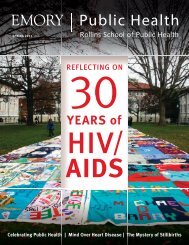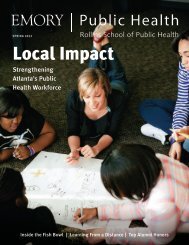medicine - Woodruff Health Sciences Center - Emory University
medicine - Woodruff Health Sciences Center - Emory University
medicine - Woodruff Health Sciences Center - Emory University
You also want an ePaper? Increase the reach of your titles
YUMPU automatically turns print PDFs into web optimized ePapers that Google loves.
induced by conventional flu vaccines in humans. “In a<br />
mouse, two years is the average lifespan,” Kang says. “We<br />
have confirmed that the VLP immune system in mice can<br />
last 18 to 20 months. So this protective immunity is maintained<br />
for about their lifetime.”<br />
In addition, the scientists had discovered another<br />
positive about VLPs. Vaccines grown conventionally typically<br />
take six months to get to market. Not so with VLPs,<br />
says Kang: “After identifying the genes to construct and<br />
make the VLPs, we can start to<br />
produce vaccines in four to six<br />
weeks.”<br />
In other words, a burdensome<br />
delay in vaccine distribution<br />
could be averted if VLP<br />
technology worked as well<br />
with swine flu as it had with<br />
seasonal influenza in mice. “So<br />
immediately we contacted the<br />
CDC,” Kang says. The Georgia<br />
Research Alliance awarded the<br />
lab and the CDC a grant to test<br />
out the VLP vaccine system with<br />
the H1N1 virus in animal models.<br />
“It’s a very good opportunity to<br />
prove our alternative vaccine<br />
system in this pandemic situation,”<br />
says Kang.<br />
Patch it<br />
If VLPs do eventually prove useful<br />
to people, they will not be<br />
alone in changing the landscape<br />
of vaccinations. After all, there<br />
are both geography and patients’<br />
personalities to consider. Some people live far from<br />
doctors, and others avoid vaccinations because of fear of<br />
side effects or needles. Those populations would be particularly<br />
vulnerable in the case of a pandemic.<br />
But those patients may soon fear not. Compans’ lab<br />
has been exploring not just new systems of vaccination<br />
but also an alternative to needle-injection vaccination,<br />
called microneedle skin patches. The patches have microscopic,<br />
barely-visible needles on their surfaces. “We coat<br />
the microneedles with inactivated flu virus or flu virus-like<br />
particles,” says <strong>Emory</strong> microbiologist Ioanna Skountzou.<br />
The patches are temporarily applied to the skin like a bandage,<br />
and the vaccine is slowly absorbed through the skin.<br />
In April, Skountzou, <strong>Emory</strong> colleagues, and collaborators<br />
from the Georgia Institute of Technology published a<br />
paper in Proceedings of the National Academy of <strong>Sciences</strong><br />
detailing the value of skin patches. The researchers<br />
showed that microneedle skin patches were just as effective<br />
as injected vaccines in immunizing mice from seasonal<br />
influenza.<br />
The microneedle skin patches could bode well for<br />
difficulties with vaccine distribution and for those with<br />
needle phobias, says Skountzou. “It can be delivered by<br />
mail and can be sent to remote places with no health care<br />
providers. It can be tolerated<br />
by patients and children with<br />
fear of injections,” she says.<br />
The skin patches have<br />
other advantages as well, says<br />
Skountzou. The skin patches<br />
are effective with a smaller<br />
vaccine dose—called vaccine<br />
sparing—than what works in<br />
typical injected vaccinations.<br />
“Vaccine sparing has several<br />
advantages. It can help<br />
eliminate side effects caused<br />
by the vaccine (skin irritation,<br />
swelling, pain), and it is less<br />
costly but can still cover the<br />
population needs,” Skountzou<br />
says.<br />
In new ongoing studies,<br />
the team is testing the<br />
microneedle skin patches<br />
on animals like guinea pigs.<br />
Skountzou is also combining<br />
the microneedle skin patch<br />
delivery with adjuvants that<br />
further stimulate immune<br />
response. She’s hoping that adjuvants boost immunity,<br />
permit lower doses of vaccine, and drive per-patient costs<br />
down even more.<br />
Lower costs, no needles, fewer doctor visits. Less need<br />
for vaccine-producing eggs. Skountzou, Kang, and their<br />
colleagues have found better ways to prevent illness and<br />
contagion. Now, as they hone their vaccination systems,<br />
they’re also focusing on new implications for their work:<br />
If you can give a patient a patch for the seasonal flu, why<br />
not also provide a patch for hepatitis or chicken pox? If<br />
you can create VLPs mimicking an influenza strain, why<br />
not try a VLP to trick the body into fighting other diseases,<br />
or all influenza varieties at once?<br />
“We can tackle many diseases and many viruses,” says<br />
Kang. “It’s very exciting.” EM<br />
Lower costs, no needles, fewer<br />
doctor visits. Less need for vaccine-<br />
producing eggs. As they hone their<br />
vaccination systems, <strong>Emory</strong> researchers<br />
also are focusing on new implications<br />
for their work: If you can give<br />
a patient a patch for the seasonal<br />
flu, why not also provide a patch for<br />
hepatitis or chicken pox?<br />
WINTER 2010 21
















